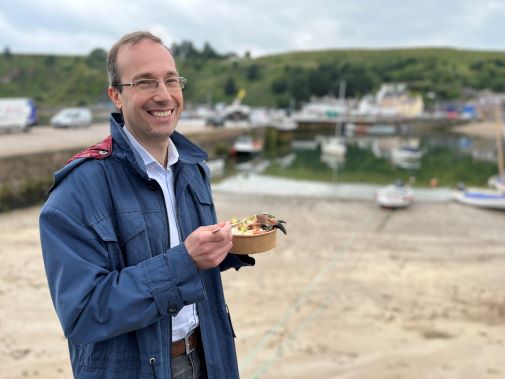It’s official, we like seafood more when we eat it by the sea
Posted on 9 August 2023
 Simone Martino: tucking into locally caught crab claws
Simone Martino: tucking into locally caught crab claws
The answer is yes, according to researchers from the University of York and The James Hutton Institute in Aberdeen.
They surveyed residents and visitors to the Scottish inshore fishing towns Mallaig and Oban and found that people were willing to pay more than three and a half times more for a portion of seafood when within view of an active inshore fisheries harbour.
The value of locally caught fish
When asked what was most important to them about their seafood, people put locally caught fish first when picking their seafood supper, followed by its environmental credentials. How fresh it was and if it had in fact been caught or harvested by more traditional small vessels were also ranked highly.
“This is a potentially undervalued link between consumers and our coastal fisheries that we could be missing out on, both in terms of economic value, but also a sense of heritage in these and other towns,” says senior researcher Simone Martino, who led the project, alongside researchers from the Scottish Association of Marine Science (Dr Clive Fox) and the University of York (Professor Jasper Kenter and research associate Elaine Azzopardi).
“Our research shows that where consumers’ seafood comes from really does drive their choices in these coastal towns and that they put tangible value on it being from living fisheries that they can see and so feel connected to,” says Martino. “This is a cultural aspect of our fisheries that we could make more from, both for local communities and the tourism sector.”
The value of marketing local seafood
While some areas are now promoting local catch and sustainability more, not all are. But there’s a value to marketing these to consumers, according to the research.
With a suitable view of live fisheries activity, seafood consumers were willing to stump up a theoretical £12.31 to £20.88, compared with a £6 baseline for a standard portion of shop-bought seafood, depending on their age group (younger people offering less), for their fish.
This amounted to more than double to three and a half times more than a baseline of £6 set for a basic portion of unattributed seafood, according to the study.
When told it was caught by small, traditional type vessels, people were willing to pay £10.51 to £17.84. Asked what they would pay if eating seafood of unknown origin in a standard restaurant, the cash offered went down to £8.71 to £14.74.
“By labelling food and sharing information about its origin, specific to local towns, its fishing heritage and living small-scale fisheries, retailers can provide extra value and help embed these values in the cultural life of their towns,” said Martino.
Embedding heritage values
“Broader policies around fishing also tend to focus fish stocks and socio-economic impacts of fishing. When there is more of a cultural focus, it tends to be about its history, through museums, but this research shows we could benefit for more focus on the living fisheries.
“Another interesting aspect of this is that, while we found that environmental certification was ranked second in terms of what people are willing to pay extra for, this certification tends to be driven by supermarket requirements, rather than the chance of getting a better price,” adds Martino.
“We also found that people do value the economic and cultural impact of fishing on their towns. Some 96% of people agreed that fishing is important from an economic perspective, while 71% of locals and 79% of visitors thought it also shaped both town’s cultural heritage, and 84% agreed that it suggested a social connection with the sea.”
The research, which has been published in the journal Maritime Studies, had funding from the European Union’s Horizon 2020 research and innovation programme (grant agreement No. 770504, PERICLES project).
Further information:
Further information is available at www.pericles-heritage.eu.
Explore more news

Poor diets fuelling health crisis in the North, report reveals
Wednesday 23 July 2025

Nightjars at real risk from decreasing genetic diversity, researchers warn
Tuesday 22 July 2025

A ‘millet mystery’ in ancient Japan reveals a complex picture of agricultural adoption, research shows
Monday 21 July 2025

Wednesday's child is not "full of woe," new study finds, debunking popular nursery rhyme
Wednesday 16 July 2025

Optical telescope on York rooftop to advance communication between space and earth
Wednesday 16 July 2025
About this research
The research, which has been published in the journal Maritime Studies, had funding from the European Union’s Horizon 2020 research and innovation programme (grant agreement No. 770504, PERICLES project).
